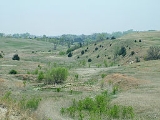
Ashfall Fossil Beds
Overview
Antelope County, Nebraska
Antelope County is a county located in the U.S. state of Nebraska, and was formed in 1871. As of 2010, the population estimate was 6,685. Its county seat is Neligh...
in northeastern Nebraska
Nebraska
Nebraska is a state on the Great Plains of the Midwestern United States. The state's capital is Lincoln and its largest city is Omaha, on the Missouri River....
are among the rare preservation sites called lagerstätte
Lagerstätte
A Lagerstätte is a sedimentary deposit that exhibits extraordinary fossil richness or completeness.Palaeontologists distinguish two kinds....
n, which preserve ecological "snapshots" from a moment in time, due to extraordinary local conditions that have preserved a range of fossil
Fossil
Fossils are the preserved remains or traces of animals , plants, and other organisms from the remote past...
ized organisms undisturbed.
The Ashfall Fossil Beds are especially famous for fossils of mammals from the middle Miocene
Miocene
The Miocene is a geological epoch of the Neogene Period and extends from about . The Miocene was named by Sir Charles Lyell. Its name comes from the Greek words and and means "less recent" because it has 18% fewer modern sea invertebrates than the Pliocene. The Miocene follows the Oligocene...
geologic epoch. The Ashfall Fossil Beds are stratigraphically
Stratigraphy
Stratigraphy, a branch of geology, studies rock layers and layering . It is primarily used in the study of sedimentary and layered volcanic rocks....
part of the Serravallian
Serravallian
The Serravallian is in the geologic timescale an age or a stage in the middle Miocene epoch/series, that spans the time between 13.65 ± 0.05 Ma and 11.608 ± 0.005 Ma...
-age Ogallala Group.
The Ashfall deposit preserves the fossilized remains of ancient animals that perished in a dense volcanic ash
Volcanic ash
Volcanic ash consists of small tephra, which are bits of pulverized rock and glass created by volcanic eruptions, less than in diameter. There are three mechanisms of volcanic ash formation: gas release under decompression causing magmatic eruptions; thermal contraction from chilling on contact...
fall which fell during the late Miocene
Miocene
The Miocene is a geological epoch of the Neogene Period and extends from about . The Miocene was named by Sir Charles Lyell. Its name comes from the Greek words and and means "less recent" because it has 18% fewer modern sea invertebrates than the Pliocene. The Miocene follows the Oligocene...
approximately 12 million years ago; the animals had come to a waterhole
Depression (geology)
A depression in geology is a landform sunken or depressed below the surrounding area. Depressions may be formed by various mechanisms.Structural or tectonic related:...
seeking relief.

